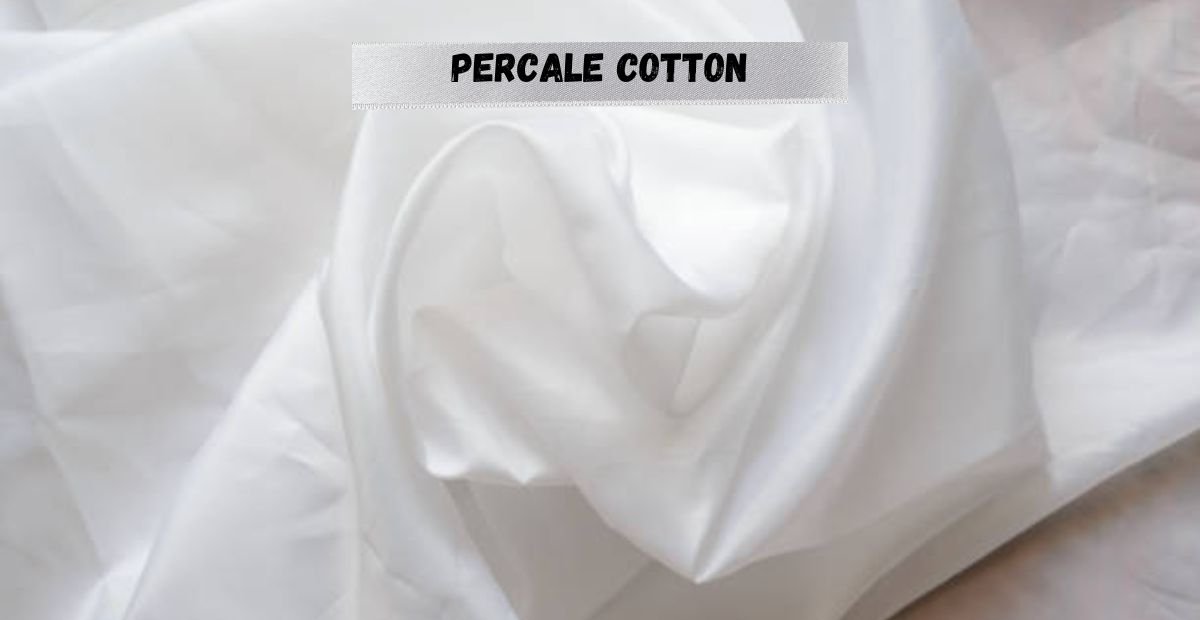Introduction: Why Percale Cotton Matters
Mostly, you will find the word percale on the labels of bedding next to cotton sheets. However, it is not clearly comprehended by many shoppers. Percale has nothing to do with any kind of cotton: in fact, it is a particular weave, and it gives a smooth, crisp feel.
Knowing the percale cotton will help the buyers make better decisions. It particularly applies to people who appreciate to breath and have a cool, hotel-like feel of sleep. This guide will reveal all about the question “what is percale cotton”, the favorite type of cotton weave – its definition and properties, its most successful applications and maintenance.
What is Percale Cotton?
Definition
Percale is an un-patterned fabric that is usually used as bedding. It is characterized by an alternate one-over, one-under simple weave. This is a classical pattern, which provides percale with its smooth and matte surface. Notably, percale is the type of weave pattern and not a particular type of cotton or brand.
Weave Pattern
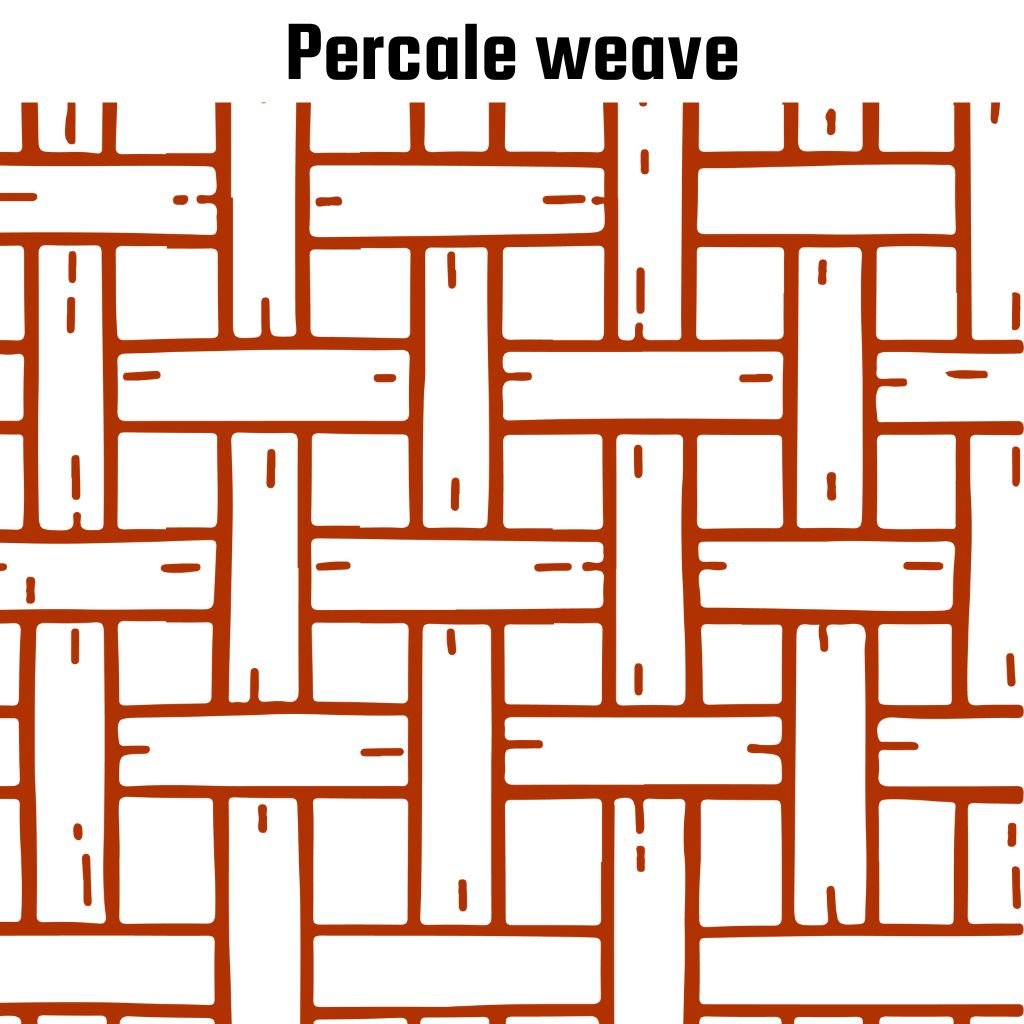
Percale is woven with a one:one (1:1) pattern. In this technique, every weft thread identically overtakes a warp thread, and then switches direction. Consequently, percale cloth is highly woven in a tight and even manner. This is a plain weave that renders the fabric strong and durable.
Thread Count
The thread count of percales ranges at 200-400 threads per square inch. This is the desired range of percale: it has a hand-feel that is crisp and breathable. Below 200 counts may be considered too coarse and above 400 may lose breathability. It is observed by many professionals that quality cotton and weave are more important than the thread counts which are extremely high.
Materials
Bedding, mostly of percale, is mostly 100% cotton, usually of high-quality long-staple fibers. Another example is Egyptian or Pima cotton percale which is particularly smooth and tough. Other fibers (such as polyester or silk) are mixed with some percale to become less expensive or include wrinkle resistance. Nevertheless, the standard in the way of luxurious feel is pure long-staple cotton percale.
Characteristics of Percale Cotton
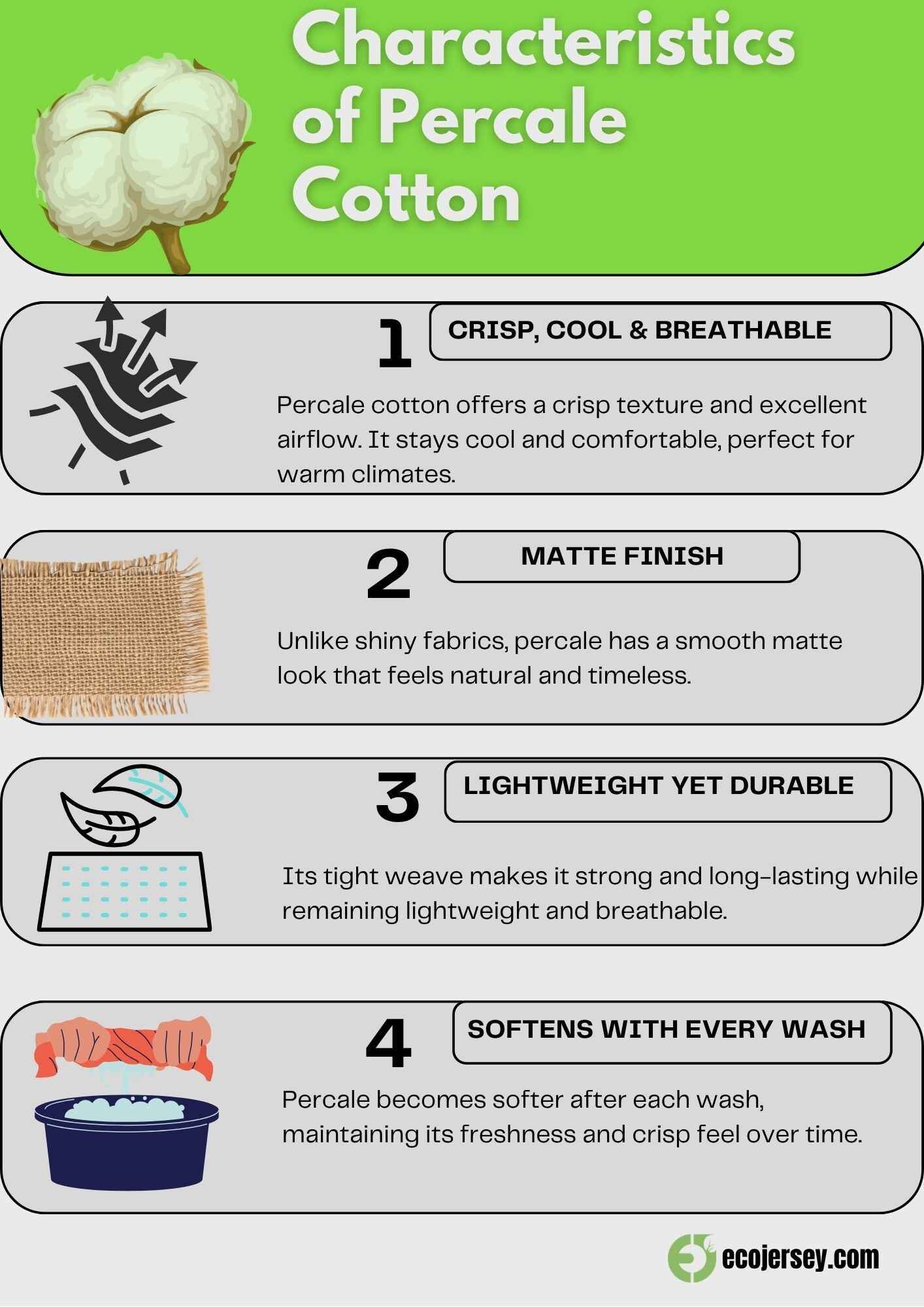
Crisp, Cool, and Breathable Feel
Percale is renowned to have a crisp and cool touch on the skin. It has a narrow but loose weave to allow air to pass freely and thus, the sheets remain cool, which is a blessing to hot sleepers. Percale loses some of its stiffness with time, yet it still manages to keep its fresh, crisp feel. Percale, in a word, is not heavy or clingy.
Matte Finish
In comparison to shiny sateen, percale is of matte or low sheen. This un-glamour is due to its plain weave, which conceals the majority of intersections of threads. The outcome is a sophisticated, restrained appearance of percale sheets and pillowcases. Percale can be said to be more classic or timeless than lustrous weaves due to the matte finish.
Lightweight Yet Durable
The percale is strong yet long-lasting even though it is lightweight. It has a one-over one-under weave that makes it a very strong fabric and wear and tear resistant. Indeed, the plain weave of percale makes it more durable than other complicated weaves. Within years of use and washing, the good percale sheet will not tear or pill.
Gets Softer with Washes
New percale may have a squeaky feel, and the firmness of the fabric will immediately disappear. Percale fibers are softened each time they pass through a wash and dry cycle. The more the sheets are used the more they become tactile and yet cool touch. This lightness is also included in the charm: percale sheets begin hard but become softer as days pass.
Percale Cotton vs Other Weaves
| Category | Percale | Sateen | Egyptian Cotton | Linen |
|---|---|---|---|---|
| Weave/Material | Plain weave (1-over-1-under) | Satin weave (3–4 over, 1 under) | Type of cotton (long-staple) | Flax fiber (loose, textured weave) |
| Feel/Finish | Crisp, matte | Silky, lustrous | Soft and smooth with quality | Airy and textured |
| Breathability | Very breathable, stays cool | Less breathable (retains more heat) | Varies by sheet | Extremely breathable and cool |
| Wrinkle Resistance | Prone to wrinkles | More wrinkle-resistant | Depends on finishing | Wrinkles easily, softens over time |
| Thread Count | ~200–400 recommended | Often 300–500 | N/A (varies by sheet) | Lower (looser weave) |
Percale vs Sateen
Percale and sateen have their differences primarily in the weave and feel. The one-over-one-under pattern of percale gives a crisp look, matte surface and the pattern of sateen (a few threads over, one under) gives a smooth and shiny surface. Practically, a sheet of percale is cool and light, and sateen is warmer than percale, which is more wrapped-in and therefore, good in hot weather. Sateen is heavier and shinier, retains body heat and prevents wrinkles slightly longer. Percale vs sateen cotton is a matter to do with your preference between crisp and cool material or soft and glossy.
Percale vs Egyptian Cotton
It should be known that the Egyptian cotton is all about the fiber, not the weave. Egyptian cotton sheets are the ones prepared using extra long staple cotton produced in Egypt. There is Egyptian percale or Egyptian sateen. Comparatively, percale informs you of the manner of weaving the fabric. That is, Egyptian cotton + percale weave = Egyptian percale and Egyptian sateen is Egyptian cotton satin woven. So percale vs Egyptian is even, as the process of weaving is to the quality of cotton: they are not alike. The two terms are frequently found in high-end sheets, that is, they employ fine cotton in a percale weave.
Percale vs Linen
Linen (constructed out of flax fibers) and cotton percale have similar appearance but differ in touch. The texture of linen is more open and loosely woven and a bit irregular and slubby. It is quite chilly and breezy, particularly during hot seasons. Percale is less rocky and smooth. Practically, linen is rather heavy and textured whereas percale is light and more acute. Both of them are breathable, the hollow fibers of linen are natural that is why it is highly moisture-wicking. In case you are an extremely hot sleeper both are good, but percale is very crisp; linen is much softer, more of a lived-in feel.
Pros and Cons of Percale Cotton
Pros of Percale Cotton
- Cool and breathable: The tight, simple weave of percale allows air to pass through keeping you comfortable and dry. Percale is a favorite of the hot sleepers due to its cooling properties.
- Hardy: Percale is extremely strong as it is plain 1-over-1 weave. Percale sheets of high quality can take many years to thin and pill.
- Grows better with age: Percale is stiff at the beginning but becomes soft. With every wash it becomes more supple and cool.
- Inexpensive: Since percale is a simple welling and medium thread counts, it is sometimes less costly than high thread sateen yet still has the luxurious feel.
Cons of Percale Cotton
- Easily wrinkles: Crisp weave will easily crease, therefore percale sheets will have to be ironed or smoothed after drying.
- New percale can initially be stiff: New percale may come a slightly sweaty out of the package. Breaking in and getting warm also requires a couple of washes.
- Less silky: Percale is firm and not so slippery on the skin compared to sateen. Others like the calmness of a satin weave.
- Cool feel not for everyone: Because it stays cool, percale may feel too crisp for those who get cold easily or want extra warmth in winter.
Best Uses of Percale Cotton
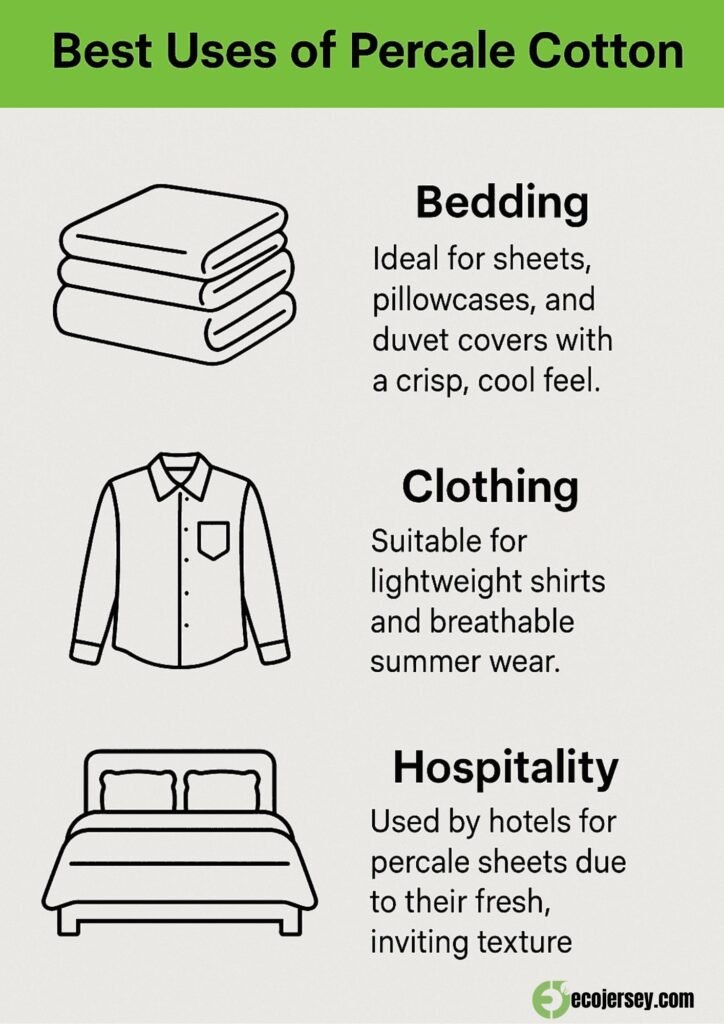
Bedding: Sheets and Duvet Covers
Percale cotton is best to use in bedding, especially pillowcases, duvet covers, sheets, etc. Its breathable quality is crisp and keeps the sleepers comfortable during the nighttime. There are a lot of bedding brands that sell percale sheets that are similar to hotel linens. Actually, crisp percale sheets are particularly good when it is hot, or in air conditioned bedrooms.
Clothing: Lightweight Garments
Percale is a lightweight and breathable garment, which is a good option to wear in warm weather. As an example, one can single out summer shirts, sleepwear, and casual button-downs, which commonly have percale-style weaves. The piece of clothing is loose-fitting and free against the skin. Nevertheless, it is more wrinkly than mixed fabrics hence, it is mostly preferred in fashion whereby crispiness is an attribute.
Hospitality: Hotel Linens
Percale is common in hotels and resorts of the high-end category. Percale sheets are common in five-star bedding since they are durable, easy to wash and have that crisp feel and look. Percale, actually, is what you will have definitely in most of the up-scale hotels. Its cool feel and fresh classic appearance make the guests feel spoiled.
Who Should Choose Percale Cotton?
Hot Sleepers and Warm Climates
Percale is your thing, whether you are a hot sleeper or reside in a warm land. It is open weave and has natural breathability, which prevents the trapping of heat keeping you cool. According to many experts, percale sheets have the ideal attribute of allowing individuals to use them throughout the year as they prefer cool bedding.
Fans of Crisp, Hotel-Style Sheets
Percale must be selected by any person who enjoys the sensation of crisp hotel bedding. It has a similar touch to a cotton shirt or tailor-made linens. Actually, the cool and crisp feel of percale is the reason why several luxury hotels prefer it. Want that clean, fresh feeling every morning, percale gives it to you.
Value-Conscious Shoppers
Percale is frequently chosen by buyers who want sheets that are durable but at a reasonable price. The weave of Percale allows you to receive high-quality bedding at a low cost without spending high money on premium sateen or silk counterparts. Meanwhile, percale does not lose in terms of durability: it can withstand frequent washing. Simply put, percale is a good option in case you want quality in the long run and you can afford it.
Caring for Percale Cotton
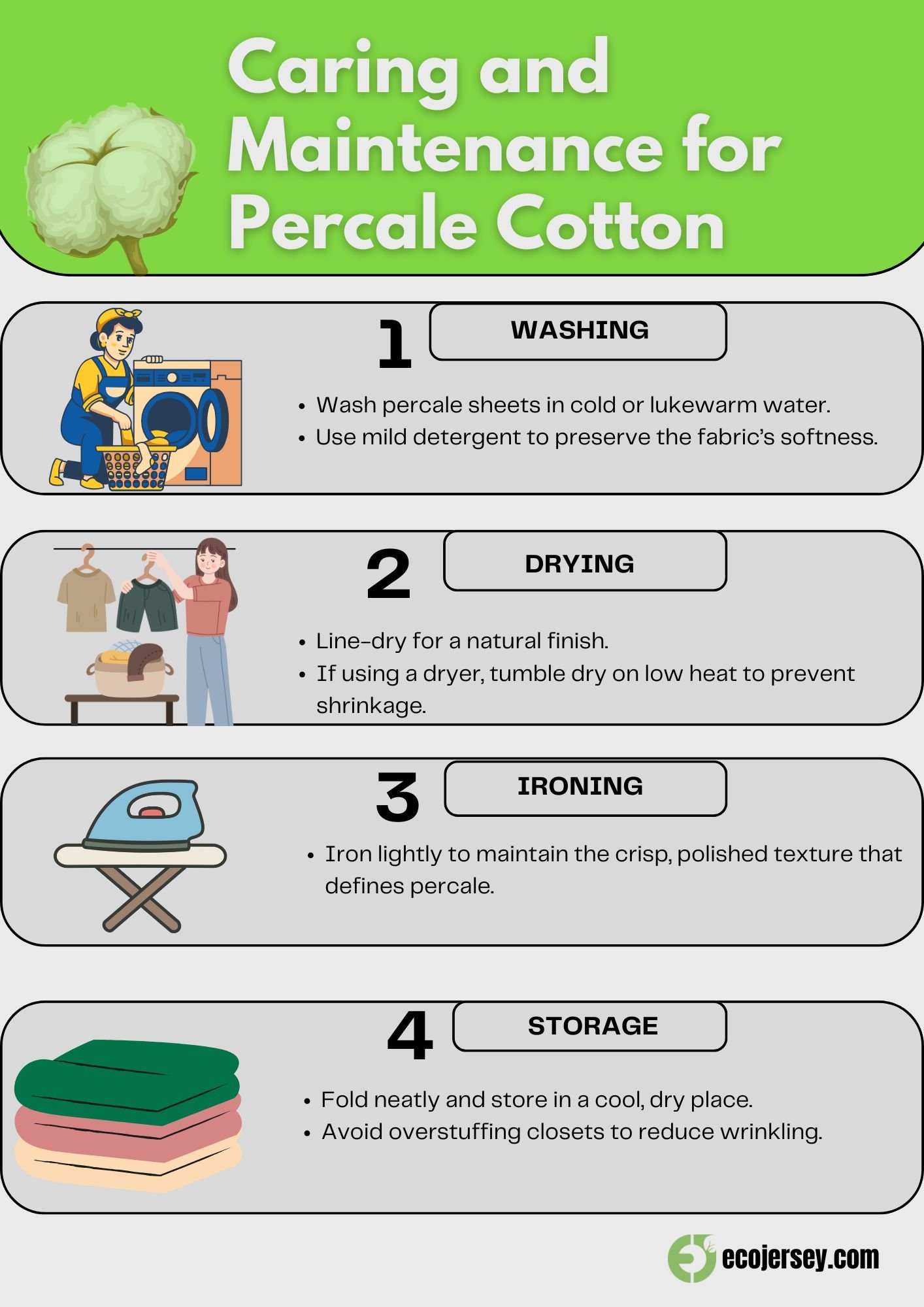
- Machine Wash: Wash percale in cold or lukewarm water in gentle cycle. Wash with a light detergent and do not use bleach or fabric softener because rough chemicals may destroy the fibers. Color and fabric cling to cold or moderate water.
- Dry: Tumble dry on low heat or best on the line. Do not overload the dryer. Take out the sheets as soon as they are fairly dry without being completely dry to avoid wrinkles. The low heat preserves the fabric of cotton against shrinking or brittle nature.
- Iron: To have an ideal smooth sheet, iron percale on a low level when damp. Percale is easier to iron when wet, and will not scald. This will give this place its crisp hotel appearance again.
- Store: Wash percale bedding, fold it and store in a cool and dry area out of direct light. White sheets may turn yellow with the passage of time under sunlight. Plastic bags should be avoided (they keep moisture in) and breathable fabric bags or drawers should be used instead.
Buying Guide: What to Look for in Percale Cotton
- Thread Count: Aim for about 200–400. The range provides a sharp hand and breathability. Extremely high thread counts are bulky in percale.
- Material: Find 100 percent long-staple cotton (Egyptian, Supima/Pima) in the percale weave. There are better cotton fibers that produce smoother and stronger sheets.
- Organic vs Conventional: Organic percale cotton does not use chemical pesticides. Check certification markings GOTS or Oeko-Tex to ensure your bedding is sensitive or environmentally friendly.
- Price: Percale sheets are available at a variety of prices. Mediocre-priced sets are usually made of cotton of good quality. Polyester blends (though not as natural) may be used in very cheap percale.
- Feel First: Ideally, touch a swatch. Percale is to be smooth but hard. A sample may serve to confirm such pleasant crispness.
Conclusion-
Percale cotton is distinguished by its crisp feel, cooling comfort and durability. Percale is also cool and breathable in contrast to sateen which is silky and warm hence suitable to people who like a clean and hotel experience in their sleep.
Percale cotton would be a perfect match to lightweight and naturally cool bedding which grows softer with time. But when you want more of a smooth and silky feel, sateen may work. Finally, you should be choosing based on your comfort preference and climatic conditions.
This is because you can now trust in a comfortable and cozy bedclothes that you can invest in and still not feel out of place when you sleep at night by knowing what is percale cotton.
FAQs
Is percale cotton good quality?
Yes. Percale cotton may refer to high quality bedding, particularly bedding of long-staple fibers. It is a strong weave that can withstand. It is the quality of cotton that is used after all: Egyptian or Pima percale is regarded as a high-quality one.
Is percale cotton soft?
First, percale is not soft but rather crisp. It however softens considerably after a couple of washes. Several sleepers have claimed that percale is softened with age, and yet does not lose its coolness.
Does percale cotton wrinkle?
Yes, percale wrinkles easier as compared to sateen. The plain weave is not crease resistant hence will wrinkle up to some extent after drying. Nonetheless, most wrinkles will be eliminated in a short time by ironing or smoothing damp sheets.
What thread count is best for percale cotton sheets?
Percale is normally at its best at 200-400 threads per inch. The sheets in this range are breathable and are strong. In the case of percale, a thread count of 300 is usually mentioned as the optimal range: it is high enough to be smooth, and not too dense.

